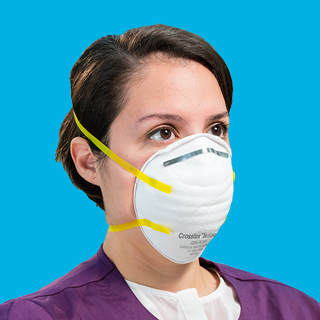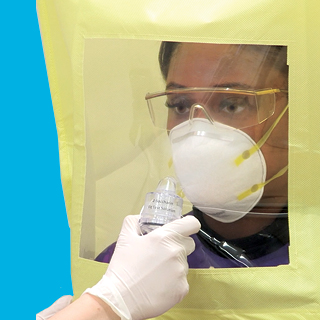Blog
Dispelling Surgical Respirator and Mask Myths

dispelling-surgical-respirator-and-mask-myths
Updated on 1/12/2024
Although we are no longer in the midst of a pandemic, dental health care professionals (DHCPs) continue to don masks and N95 respirators to protect themselves and their patients from the risk of exposure to respiratory transmitted diseases. Among the many health professions, the dental community has understood and internalized the need for face and respiratory protection, whether it’s to protect from tuberculosis, influenza or COVID. Even though compliance with standard precautions is generally high in dental, many practitioners may have questions and misconceptions about mask and respirator use, particularly given the evolving recommendations, guidance and general chatter coming out of the pandemic from traditional and not-so-traditional channels.
Given that dental practice owners are also responsible for maintaining a safe working environment for their employees, now is an excellent time to evaluate current infection prevention guidance, dispel the myths and adopt up-to-date protocols to ensure they account for the ongoing reality of today’s viral exposure risk. That means establishing realistic best practices related to surgical respirator and mask usage.
The challenge is making sure all DHCPs share the same understanding of the current guidance and the appropriate selection and usage of surgical masks and N95 respirators.
What Is the Latest Guidance?

The federal COVID-19 Public Health Emergency may have ended on May 11, 2023; however, the Centers for Disease Control and Prevention’s Interim Infection Prevention and Control Recommendations for Healthcare Personnel During the Coronavirus Disease 2019 (COVID-19) Pandemic continue to apply.
Changes were made to the Interim Recommendations to account for the end of community-level transmission tracking. However, the CDC encourages all dental health professionals to continue to identify individuals with suspected or confirmed SARS-CoV-2 infection prior to treatment, ensure that dental healthcare professionals wear recommended PPE, and use additional mitigation methods when performing aerosol-generating procedures, particularly during periods of higher transmission.
The CDC specifies additional recommendations for dental practices
- Regularly consult their state dental boards and state or local health departments for current information as well as recommendations and requirements specific to their jurisdictions.
- Practices should postpone all non-urgent dental treatment for patients with suspected or confirmed SARS-CoV-2 infection, or those who have had close contact with someone with SARS-CoV-2 infection, until they meet criteria to discontinue Transmission-Based Precautions and end quarantine. If emergency, medically necessary treatment is required, DHCP should:
- Follow all recommendations for care and placement for patients with suspected or confirmed SARS-CoV-2 infection.
- Pay extra attention to ensure HVAC ventilation to the dental treatment area does not reduce or deactivate during occupancy based on temperature demands.
- When performing aerosol-generating procedures on patients who are not suspected or confirmed to have SARS-CoV-2 infection, ensure DHCP correctly wear the recommended PPE (including consideration of a NIOSH-approved particulate respirator with N95 filters or higher as SARS-CoV-2 community transmission increases) and use mitigation methods such as four-handed dentistry, high evacuation suction, and dental dams to minimize droplet spatter and aerosols.
- Commonly used dental equipment known to create aerosols and airborne contamination include ultrasonic scaler, high-speed dental handpiece, air/water syringe, air polishing, and air abrasion.
- Provide dental treatment in individual patient rooms whenever possible with the HVAC in constant ventilation mode.
- Create strategies to prevent the spread of pathogens in dental facilities with open floor plans, including:
- At least six feet of space between patient chairs.
- Adjunct use of portable HEPA air filtration systems to enhance air cleaning.
- Physical barriers between patient chairs. Easy-to-clean floor-to-ceiling barriers will enhance effectiveness of portable HEPA air filtration systems (check to make sure that extending barriers to the ceiling will not interfere with fire sprinkler systems).
- Operatories oriented parallel to the direction of airflow when possible.
- Carefully considered patient orientation carefully. Where feasible, place the patient’s head near the return air vents, away from pedestrian corridors, and toward the rear wall when using vestibule-type office layouts.
- Ensure to account for the time required to clean and disinfect operatories between patients when calculating your daily patient volume.
Regardless of current guidelines, hospital systems in several states have reinstated the use of masks on site.
Surgical Respirator and Mask Myths
Myth: Surgical masks are not effective at preventing respiratory disease transmission
In a May 2023 Annals of Internal Medicine article entitled, For Patient Safety, It Is Not Time to Take Off Masks in Health Care Settings,
authors Tara N. Palmore, MD, and David K. Henderson, MD, cite the reasons why health care practitioners should continue donning surgical masks in health care settings to prevent respiratory disease transmission:
Most published studies addressing mask efficacy have methodological flaws, and adherence to mask wearing has been suboptimal in virtually all. Demonstrating that masks work is difficult when they are not worn consistently. Although gold-standard evidence is not available, we argue that, despite the lack of clinical efficacy trials (as with the widely accepted practice of hand hygiene), masking in interactions between patients and health care personnel should continue to receive serious consideration as a patient safety measure.
Myth: ASTM Level 3 surgical masks provide the same level of protection as N95 surgical respirators
While both ASTM Level 3 surgical masks and N95 surgical respirators may be associated with similar infection risk in routine patient care settings, a beneficial effect of N95 respirators cannot be ruled out,
according to another May 2023 article in Annals of Internal Medicine entitled, Major Update: Masks for Prevention of SARS-CoV-2 in Health Care and Community Settings—Final Update of a Living, Rapid Review.
CDC recommendations specify N95 surgical respirators as offering better source control as well as protection to the wearer because they are designed to fit more securely. When used as part of a workplace respiratory protection program, the Occupational Safety and Health Administration (OSHA) also mandates the need for training and fit testing according to well-established and defined protocols, which enhances the overall effectiveness of N95 use as the respirator tested has been shown to fit and work as intended at a set level for the specific user.
Ultimately, DHCP should follow guidelines and use surgical respirators and masks that offer the best fit and protection possible, weighing respiratory disease transmission levels in their community, the health status/history of the patient being treated, and the type of procedures being conducted, particularly if they aerosols are generated or present.
During times when respiratory disease transmission levels are low and/or when performing non-aerosol-generating procedures, a high-quality ASTM Level 3 surgical mask may be an appropriate choice. During flu season, with a patient known to be carrying a respiratory disease, while performing aerosol generation procedures or if the clinician has specific safety-related concerns, a surgical N95 respirator may be the best option. Under the latter condition, employers may allow employees to choose an N95 respirator on a voluntary basis.
The use of respirators is not regarded as mandatory unless required under the respiratory protection standard and/or the employer requires that employees wear respirators regardless of the exposure assessment results. Regardless, when using N95 surgical respirators, they must meet NIOSH and FDA standards for user fit, fluid resistance, filtration, and exposure control.
Myth: All surgical masks and respirators fit the same
When it comes to infection prevention, fit does matter. According to the CDC, a poorly fitting or improperly worn respirator or mask may reduce its intended benefit.
The key for proper use of surgical masks and respirators is to reduce gaps and have as tight a seal as possible considering the face size and shape. Keep in mind that facial hair plays a role in fit and function, especially with N95 use.
There are designs that may prove to be a good option to fit the most people across your team, allowing for better overall performance and standardization.
Secure Fit™ Technology, which is exclusive to Crosstex ASTM-rated surgical earloop masks, offers a patented design featuring flexible aluminum nose and chin strips for a customized fit that eliminates dangerous gaps around most face shapes. Independent laboratory testing has confirmed that Secure Fit Technology offers superior protection when compared to standard earloop masks.1,2
When utilizing surgical N95 respirators, CDC mask fitting guidelines include two requirements:
- The respirator should collapse slightly while inhaling.
- There should be no gaps or leakage around the face and under the chin while exhaling.
In addition, as noted above, wearers of N95 respirators as part of a practices respiratory protection program are subject to a fit test to make sure no contaminants seep through in either direction. A Qualitative Fit Test (QLFT) is performed using either a Saccharin or Bitrex® solution that is introduced as a fine mist to the air just outside the respirator using a nebulizer and test hood. To pass the fit test, the mask wearer should not be able to detect either solution while performing a number of different exercises. Qualitative Fit Testing is affordable and can be performed in-office by staff members.
Another option is Quantitative Fit Testing (QNFT) which uses a machine to generate a numerical assessment of respirator fit with a passing fit score of 100 or more of a possible 200. This testing measures the quantities of particulates that leak from the environment into the mask. QNFT can be performed by a third party or with an investment in the proper equipment..
When it comes to surgical respirators, HuFriedyGroup offers three, made-in-the-USA respirator designs to help you Find Your Fit
and achieve a passing fit test score:
- The Crosstex™ Isolator™ Duckbill Surgical N95 Respirator has a flat-fold, duckbill design with dual head straps and a malleable nose piece for the best filtration, fit and comfort. It is NIOSH-approved for use when treating patients with airborne diseases and meets the guidelines for TB exposure control.
In addition, this surgical N95 respirator complies with the NIOSHASTM F3407 Respirator Fit Capability Standard. While currently voluntary for surgical N95 respirator manufacturers but may eventually become required. A surgical N95 respirator that passes this standard is more likely to fit a larger population of working adults, which may reduce the number of styles a practice needs to keep on hand. It may also reduce the amount of fit testing required, since the respirator should be a better fit for more people.
This surgical N95 respirator is perfect for anyone who may find surgical respirators to be claustrophobic or make breathing difficult. The duckbill shape creates space between the wearers mouth and nose and the mask itself. Fit correctly, the wearer can breathe more easily while minimizing the risk of infection or exposure.
- The Crosstex™ Isolator™ Molded Surgical N95 Respirator offers among the highest level of fluid resistance. Featuring a durable, collapse-resistant double-shell design, the Isolator Molded Surgical Respirators also NIOSH-approved for use when treating patients with airborne diseases and like all Crosstex surgical N95 respirators meets the guidelines for TB exposure control.
- The Crosstex™ Isolator™ Plus Surgical N95 Respirator has a classic flat-fold, chin-pocket construction that provides increased comfort. It has malleable nose and chin pieces that allow the mask to be fit to a variety of face shapes and sizes.
Myth: Surgical N95 respirators and surgical masks are uncomfortable

A common complaint about surgical masks and surgical N95 respirators is that they’re uncomfortable to wear, especially for long period of time. Specifically, that the mask or respirator may be tight, cause skin irritations or make it difficult to breathe.
Actually, both complaints are signs that you may not be wearing the right mask to fit your face, thus the need for custom fitting and masks that are designed to fit a range of face shapes.
In addition to earloop masks with Secure Fit Technology, certain features can help make masks more comfortable for wearers or improve their performance (and, therefore, boost patient and practitioner safety).
- Sensitive masks. Some masks include soft, ink and dye-free inner layers that may offer enhanced comfort for users.
- FogFree™ masks include a strip on the inner layer that prevents glasses and eye protection from fogging up and obscuring the vision of hygienists and dentists.
- Color options. Colors can do more than make masks look nice or complement your practice’s color scheme. Color cues can help dental professionals quickly differentiate between ASTM levels, which increases efficiency and aids with compliance – especially in larger practices.
Myth: I don’t need to change my mask after every patient

The CDC requires the removal and discard of masks after each use, and a new mask should be donned with each new patient. In addition, if your mask becomes saturated in any way during the care of a patient, a new mask should be donned. CDC guidelines on single-use devices offer more detail:
If your mask is damaged or soiled, or if breathing through the mask becomes difficult, you should remove the face mask, discard it safely, and replace it with a new one.
According to the Food and Drug Administration a single-use device, also referred to as a disposable device, is intended for use on one patient during a single procedure. It is not intended to be reprocessed (i.e., cleaned and disinfected or sterilized) and used on another patient. If a device does not have reprocessing instructions, regardless of labeling, it should be considered single-use and disposed of appropriately (i.e., according to federal, state, and local regulations) after one use.
Donning and removing masks
Cross contamination increases considerably when surgical N95 respirators or surgical masks are improperly donned or removed. The CDC recommends that dentists and hygienists don surgical N95 respirators or surgical masks before any contact with patients—preferably before entering the exam room. They should be removed and discarded carefully, followed immediately by hand hygiene.
Another reason for single-use respirators or masks has to do with wear. While masks provide protection, they also wick moisture. The longer you wear a mask, the less protection it may provide.
DHCPs Should Clearly Understand the Most Current Guidelines
DHCPs must wear surgical masks and N95 respirators that are fitted to their faces, and they must replace those masks after every patient. The best way to dispel the myths associated with surgical masks and surgical N95 respirators is to make sure everyone in your dental practice understands and follows appropriate guidelines to protect themselves and your patients.
The CDC has published a useful Healthcare Provider Toolkit that can help dental practices prepare their patients for the fall and winter virus season
To learn more about our surgical masks, surgical N95 respirators, and fit test kits, visit HuFriedyGroup N95 Respirators & Fit Test Kits.
1 2018. Reducing Leakage of Surgical Masks/J. Samuel, G.C. Smaldone, Stony Brook Medicine [Poster], ATS 2018, May 21, 2018, San Diego, CA.
2 Patel RB, Skaria SD, Mansour MM, Smaldone GC. Respiratory source control using a surgical mask: An in vitro study (published correction appears in J Occup Environ Hyg. 2022 Jun;19(6):409]. J Occup Environ Hyg. 2016;13(7):569-576. doi:10.1080/15459624.2015.1043050

